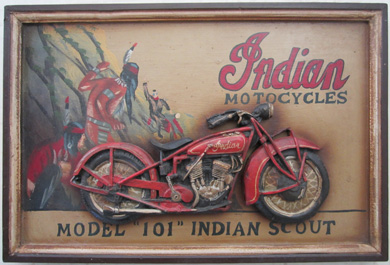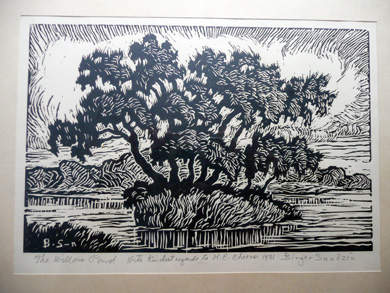 |
|
|||
 |
 |
|||
Copyright © Harry Rinker, LLC 2015 Questions
and Answers
QUESTION: I have a 19 inch by 13 inch, wooden, painted sign advertising the Indian Motorcycle “Model 101 Indian Scout.” The center of the sign features a flat, three-dimensional model of the motorcycle glued to a painted background. The left side pictures two Indians on the side of a mountain looking down on a trail upon which a rider on an Indian motorcycle is racing toward the front of the sign. What is the value of my sign? – RW, Reading, PA, Email Question.
ANSWER: The Indian Motorcycle Company, located in Springfield, Massachusetts, began as the US Hendee Manufacturing Company in 1901. In 1928, US Hendee changed its name to the Indian Motorcycle Company. By the mid-1910s, US Hendee became the largest manufacturer of motorcycles in the world. The Scout (1920 to 1946) and The Chief (1922-1953) were its most popular models. The company went bankrupt in 1953. In 2011, Polaris Industries purchased the Indian brand name, manufacturing motorcycles at present under the Indian name in Minnesota and Iowa. Charles B. Franklin designed the V-twin engine Scout which was first sold in October 1919 as a 1920 model. Franklin also designed the Scout Model 101, often referred to by collectors as the best Indian motorcycle ever made. New features on the Model 101 included a larger fork rake, lower seat height, and longer wheelbase. Depression era economics forced the discontinuation of the model 101 Scout in 1931. It was replaced by the Standard Scout in 1932. [See: https://en.wikipedia.org/wiki/Indian_Scout_%28motorcycle%29} In researching advertising signage for the Indian Scout Model 101, I found examples of two tin signs whose images are identical to the sign you own. The artwork is crisper on the tin signs. Upon close examination, subtle differences between the image on the tin signs and your wooden sign were discernible. The critical question is the origin of your sign. Is it a mass-produced piece of company advertising, a mid- to late 20th century reproduction, or a one-of-a-kind basement workshop product. If it is one of the first two options, my research should have uncovered additional examples. I did not. Although my mind tells me to favor the reproduction origin, I am going with the basement workshop origin. I studied the illustration you sent carefully. The quality of workmanship favors a skilled amateur as opposed to a professional artist. I also am puzzled by the wear patterns. This is one of those times when I wish I actually could handle the piece. If I am correct, the secondary decorative market value of your sign is between $100.00 and $125.00. An Indian Model 101 motorcycle collector would pay more, perhaps double. I hate playing the woulda, coulda, shoulda game. I am going to violate my rule in this instance. If the sign would prove to be a period advertising piece, the value exceeds $750.00. QUESTION: I have a black and white linocut by Birger Sandzén. The inscription on the bottom reads: “The Willow Pond / With Kindest regards to H. C. Cheever 1931 / Birger Sandzén.” The image is approximately 9 inches by 6 inches, the simple black painted wood frame measures 16 inches by 13 inches. My research.indicates the print may be worth over $200.00. What do you think? – KJ, Bozman, MT
ANSWER: Although known as an “American” artist and printmaker, Sven Birger Sandzén (02/05/1871 – 06/22/1953) was born in Blidsberg, Ulrichehamm Municipality, Västra Götland, Sweden. Academically trained in Sweden and Paris, he moved to Lindsborg, Kansas in 1894 to teach at Bethany College. He met Alfrida Leksell, a Bethany piano student, in 1897. They married in 1900. Sandzén remained at Bethany College until he retired in 1946. Sandzén was well known throughout the American Art Community. He organized the Prairie Water Color Painters and was a charter member of the Prairie Print Makers. He held memberships in painting, printmaking, and watercolor clubs in New York, Philadelphia, and Taos. He was a guest artist at numerous universities in the Midwest and West. According to the Birger Sandzén Memorial Gallery’s biography, Sandzén “completed in excess of 2600 oil paintings and over 500 watercolors. He created 207 lithographs, 94 block prints, and 27 drypoints, which when the editions are totaled amount to over 33,000 prints. In addition he was a consummate draftsman, filling over 80 sketchbooks.” Sandzén used wood or linoleum to create his block prints. His linoleum cut blocks date from 1921. He did not print from his blocks. Printing was done by either the Bethany Press or “Lindsborg News-Record.” Again, based on information from www.sandzen.org, the website of the Birger Sandzén Memorial Gallery, “Sandzén created 94 block prints (17 are traditional woodcuts, 34 are nailcuts and 43 are linoleum cuts.” The standard art gallery asking price for a Sandzén block print is between $400.00 and $500.00. A few larger block prints exceed that range. An asking price is not the same as a getting price. The standard art gallery commission is 50 percent. Given this, your assumption that the secondary market value of your print is somewhat over $200.00 is correct. Think private sale secondary market retail value between $250.00 and $300.00. I was unable to identify “H. C. Cheever.” As a result, I have not added any extra value to the print. If H. C. Cheever can be identified, add another 20 percent to the value. QUESTION: I own an old hearse. I thought it would be fun to add a tiger’s tail to the gas cap for Halloween, remembering something similar from the 1960s. How do I acquire one of these period tiger tails and what is a fair price to pay? – H, West Chester, PA ANSWER: In 1964, McCann Erickson developed an advertising campaign for Esso based on the slogan “Put a Tiger in Your Tank!” The campaign was an immediate success, with “Time Magazine” declaring 1964 as “The Year of the Tiger.” Many individuals confuse the Esso Tiger with Kellogg’s Tony the Tiger. Kellogg’s Tony the Tiger debuted in 1951 and has served as the mascot for Kellogg’s Frosted Flakes breakfast cereal. The Esso Tiger had no specific name. As part of the Esso Tiger campaign, Esso service stations sold fake tiger tails that could be attached to a vehicle’s gas cap. Final sales exceeded 2.5 million. The Esso Tiger disappeared in the early 1970s, a victim of the oil crisis. He did not go without a fight. Esso launched advertising campaigns in America and Europe focused on “Save the Tiger.” I have several items from the 1968 German campaign in my collection. [TRIVIA QUIZ: Name the country in which the Esso Tiger first appeared] When in doubt for something like this, turn to eBay. Period Esso Tiger tails are plentiful. Prices range between $5.00 and $8.50 plus shipping. Beware of two issues when buying an example. First, make certain the rubber ring that allows the tail to be attached to the gas cap still is present and useable. Second, do not buy faded (used) examples. Sunlight and weather bleached the period color. QUESTION: I came across an answer you gave in a September 13, 1998, “Rinker on Collectibles” column regarding the Great Moments in American History jigsaw puzzles issued by the Humble Oil Company. Apparently, Humble also issued a book, cards, prints, and stamps using the same images. I have several of these prints, each measuring 18 1/2 inches x 15 3/8 inches. I cannot find any information as to their value. Is it safe for me to assume they are rare? – RM, Email Question ANSWER: No, it is not safe to assume there are rare, especially if you view rare as synonymous with valuable. The items associated with Humble’s “Great Moments in American History” campaign were mass-produced. When I encounter this type of question, my stock answer is: “Where did you look?” Humble Oil Company’s “Great Moments in American History” campaign began in 1969. Because of the subject matter of the images, several have strong value to the crossover collector. For example, the John Glenn orbits the earth appeals strongly to the space collector. Prints from the series appear for sale regularly on the internet. The average asking price per print ranges between $10.00 and $15.00 plus shipping. Comparison shopping will result in a price per print of $12.00 or less. TRIVIA QUIZ ANSWER: The Esso Tiger first appeared in advertising in Norway in the first decade of the 20th century. He debuted in the U.S. after World War II, closely resembling Tigger in “Winnie-the-Pooh.” The Esso Tiger was re-imagined for the 1960s Esso advertising campaign.]Harry L. Rinker welcomes questions from readers about
collectibles, those mass-produced items from the twentieth and twenty-first centuries.
Selected letters will be answered in this column.
Harry cannot provide personal answers.
Photos and other material submitted cannot be
returned.
Send your questions to: Rinker on Collectibles, 5955 Mill
Point Court SE, Kentwood, MI 49512.
You also can e-mail your questions to
harrylrinker@aol.com.
Only e-mails containing a full name and mailing address
will be considered.
You can listen
and participate in
WHATCHA GOT?, Harry’s
antiques and collectibles radio call-in show, on Sunday mornings between 8:00 AM
and 10:00 AM Eastern Time.
If you
cannot find it on a station in your area,
WHATCHA GOT?
streams live on the Internet at www.gcnlive.com.
SELL, KEEP OR TOSS?: HOW TO DOWNSIZE A HOME,
SETTLE AN ESTATE, AND APPRAISE PERSONAL PROPERTY
(House of Collectibles, an imprint of Random House Information Group, $17.99),
Harry’s latest book, is available at your favorite bookstore and via
www.harryrinker.com.
|
||||

